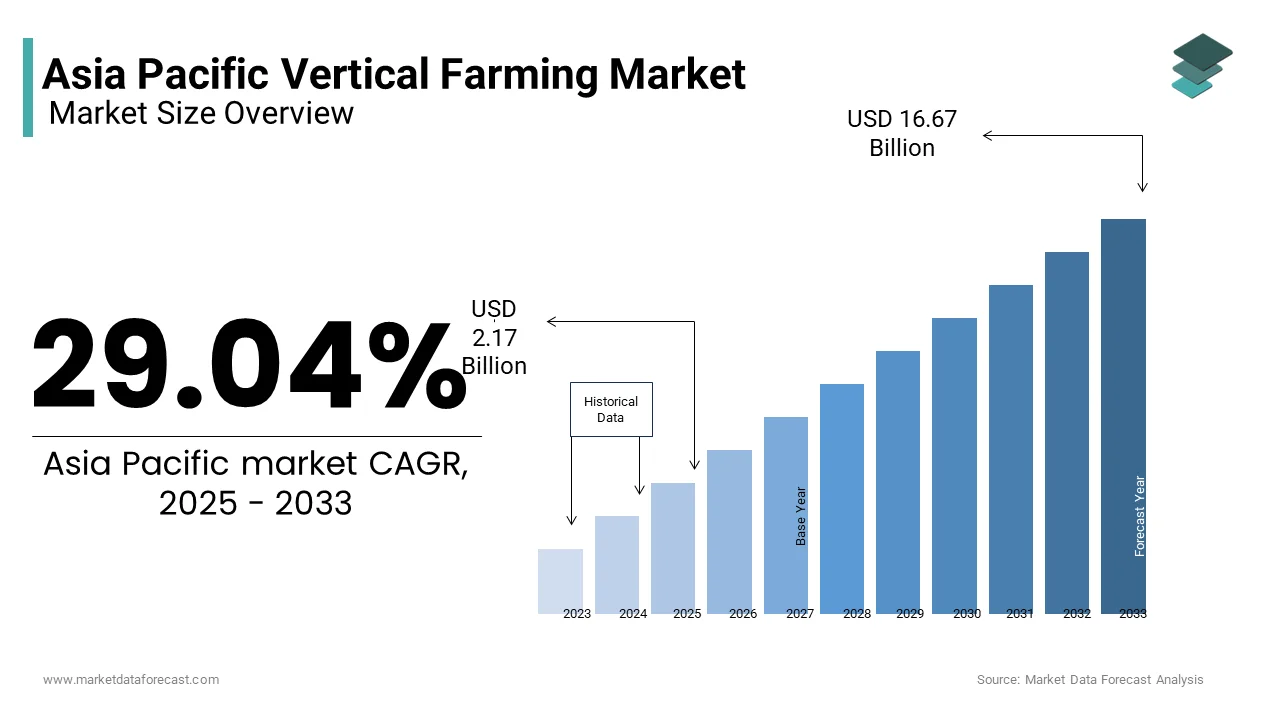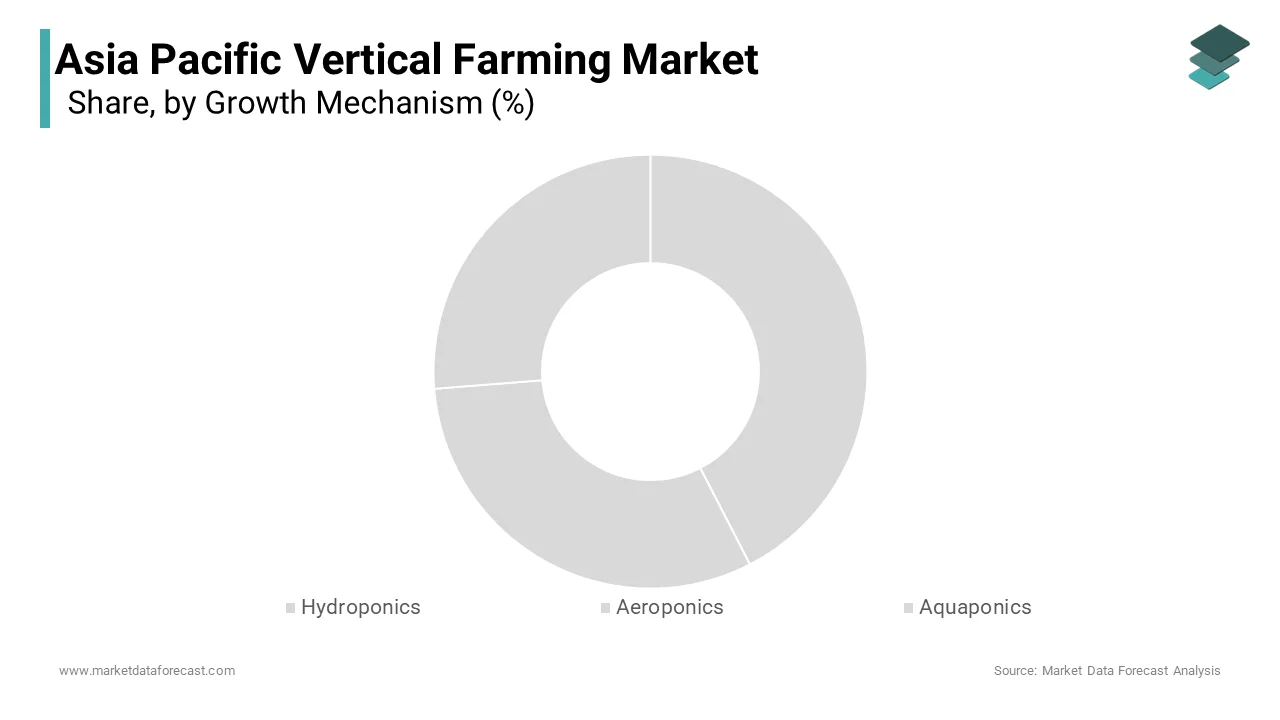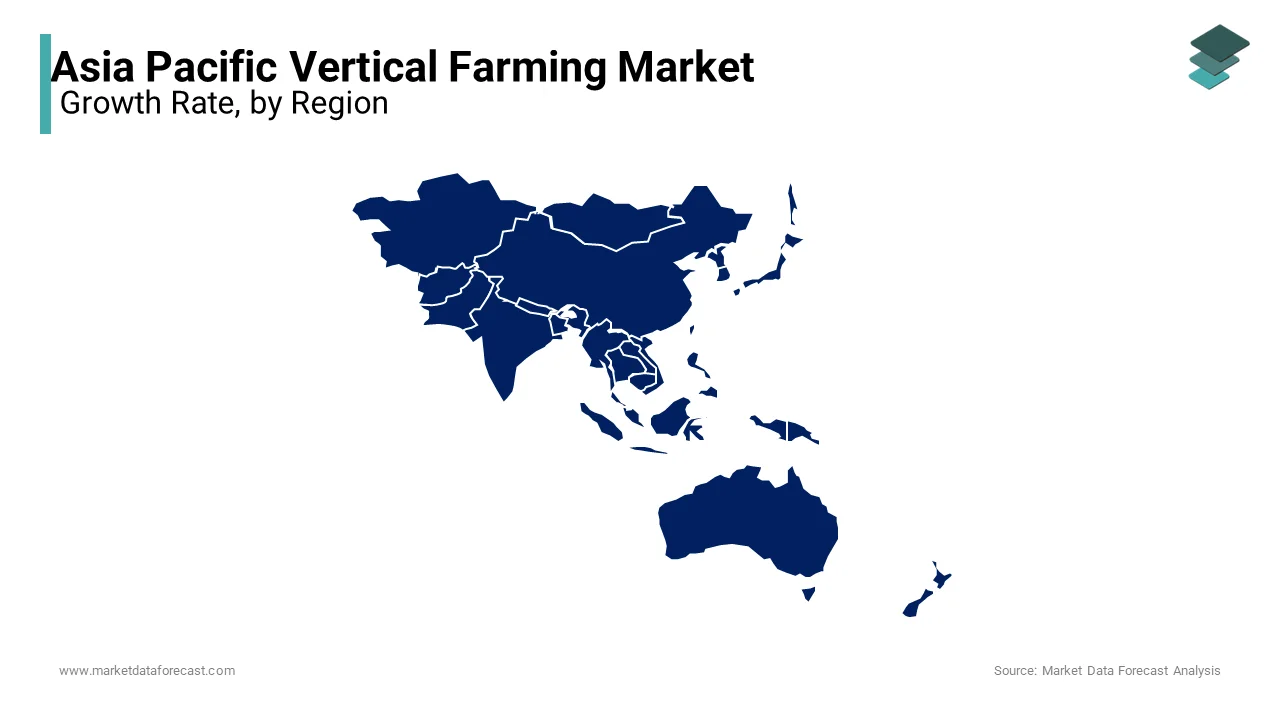Asia-Pacific Vertical Farming Market Size, Share, Trends & Growth Forecast Report, Segmented By Growth Mechanism, Structure, Offering and Country (India, China, Japan, South Korea, Australia, New Zealand, Thailand, Malaysia, Vietnam, Philippines, Indonesia, Singapore and Rest of APAC), Industry Analysis (2025 to 2033)
Asia-Pacific Vertical Farming Market Size
The Asia-Pacific vertical farming market was valued at USD 1.68 billion in 2024 and is anticipated to reach USD 2.17 billion in 2025 from USD 16.67 billion by 2033, growing at a CAGR of 29.04% during the forecast period from 2025 to 2033.

The decreasing availability of land for agriculture due to urbanization, deforestation, and climate change is accelerating the adoption of vertical farming in the Asia-Pacific region and driving market growth.
Vertical farming plays a vital role in reducing the environmental impact of agriculture. Due to deforestation, traditional agriculture practices are decreasing due to insufficient land. Vertical farming uses a small space of land for cultivation and eliminates the use of chemicals and pesticides. More productivity is observed in vertical farming compared to traditional farming with the same amount of land or even less. Vertical farming uses hydroponics and aeroponics techniques to produce crops. Vertical farming reduces tater consumption and decreases the need for pesticides by increasing tood productivity. This process is independent of the weather conditions, as outdoor farming is highly affected by the fluctuations in weather compared to indoor farming. Increasing soil pollution significantly results in poor agricultural practices, inefficient irrigation, and low-quality food. The pollution problem can be solved by vertical farming, similar to indoor farming.
The growing demand for organic food among people is boosting the vertical farming market growth in the Asia-Pacific region. People are becoming more aware of the health issues caused by consuming chemically cultivated food products. Vertical farming helps cultivate pesticide-free and organic crops, which attracts people. Countries with high disposable incomes, like China, prefer pesticide- and pollution-free food products as they consider organic foods to be premium food with high consumption. In the case of middle-income countries, the growth is still at an early stage due to low awareness among the people. Imported organic foods and beverages are gaining traction due to their increased health benefits.
The growing incorporation of automation in agriculture is expected to accelerate the vertical farming market expansion. Smart farming helps farmers cultivate by providing accuracy in crop requirements and decreasing manual labor. Automation decreases labor costs and helps farmers make necessary decisions. Vertical farming monitoring systems with the Internet of Things (IoT) that collect data and visualize it with web apps have gained traction in recent years, which is expected to create opportunities for market expansion over the forecast period.
Vertical farming requires more investment initially due to its higher cost. The facilities required for vertical farming in urban areas cost a lot. As vertical farming is done without insects, pollination is done by hired labor, and skilled labor is expensive in urban areas. These factors are hindering the market value in the Asia-Pacific region.
High energy consumption is the primary challenge facing the Asia-Pacific vertical farming market's growth. Vertical farming techniques in the region are highly dependent on electricity and fossil fuels. Traditional lighting technologies and high-pressure sodium lamps consume much energy, whereas traditional agriculture uses sunlight for plant development.
REPORT COVERAGE
|
REPORT METRIC |
DETAILS |
|
Market Size Available |
2024 to 2033 |
|
Base Year |
2024 |
|
Forecast Period |
2025 to 2033 |
|
CAGR |
29.06% |
|
Segments Covered |
By Growth Mechanism, Structure, Offering, and Country |
|
Various Analyses Covered |
Global, Regional and Country Level Analysis; Segment-Level Analysis; DROC; PESTLE Analysis; Porter’s Five Forces Analysis; Competitive Landscape, Analyst Overview of Investment Opportunities |
|
Country’s Covered |
India, China, Japan, South Korea, Australia, New Zealand, Thailand, Malaysia, Vietnam, Philippines, Indonesia, Singapore, and the Rest of APAC. |
|
Market Leaders Profiled |
Illumitex Inc. (U.S.), Aerofarms (U.S.), Koninklijke Philips N.V. (The Netherlands), and Sky Greens (Singapore) are some of the major players in the APAC vertical farming market. |
SEGMENT ANALYSIS
By Growth Mechanism Insights
The hydroponics segment is dominated, with the largest share in the Asia-Pacific vertical farming market revenue. Hydroponics uses water and nutrients for plant cultivation without soil and delivers highly efficient crops. Compared to traditional methods, it requires less space and water, which makes it a popular choice. Hydroponics attracts commercial growers due to its variable benefits, such as complete control over cultivation, high sustainability, eco-friendliness, and high-quality yield.

By Structure Insights
The building-based vertical farming segment dominated the market in 2023 and is expected to continue to do so in the forecast period. Its versatility allows it to operate in any location without consideration of weather and climatic changes. Resources such as water, space, and energy are maximized by building vertical farming. This type of farming can help countries facing difficulties with traditional agricultural methods.
By Offering Insights
The hardware segment held a significant share of the vertical farming market revenue due to the increased adoption of automation in agricultural practices. Adopting automation in vertical farming helps reduce labor costs by increasing efficiency with rapid procedures. The cloud-based software segment has been gaining traction recently and is projected to dominate in the forecast period due to vertical farming management software that collects and stores data.
COUNTRY ANALYSIS
The Asia Pacific region held the second-largest vertical farming market revenue share in 2023. China is expected to dominate the Asia-Pacific market with significant market revenue in the forecast period due to the presence of key market players in vertical farming. The increasing adoption of vertical farming due to pesticide-free and organic products is enhancing the market growth. Countries like Japan and China, which have high economic status, prefer organic food to maintain a premium lifestyle. Developing countries like India, Malaysia, and Vietnam are increasing their vertical farming adoption, which is still at an early stage. South Korea and Australia are increasing their vertical farming skills due to high productivity and efficient food products. Increasing government initiatives for indoor farming are projected to create opportunities for market expansion in various Asia-Pacific countries. The rising advancements in technology in agriculture are accelerating market growth.

The Japanese vertical farming market is expected to grow at a CAGR of 9.45% during the forecast period. Government authorities' focus on developing innovative techniques to control and prevent diseases is escalating the growth rate of the Japanese vertical farming market. Changes in diet to lead a healthy lifestyle are another attribute prompting the demand for vertical farming. Due to Japan's increasing population and limited agricultural space, vertical farming is becoming popular as it produces a high quantity of agricultural products.
The vertical farming market in South Korea is expected to showcase prominent growth opportunities due to the growing prominence of producing year-round in controlled environments. Government organizations' funding of vertical farming through investments is also ascribed to fueling the market's growth rate. Increasing awareness of the benefits of adopting vertical farming significantly influences the market's growth rate.
The vertical farming market in Singapore is anticipated to grow at a healthy CAGR during the forecast period. The trend towards cultivating a variety of crops using the latest technology that reduces the imports of food from various countries is ascribed to bolstering the growth rate of the Singapore vertical farming market. Also, a growing number of companies focusing on vertical farming to meet the demand for producing local foods are inclined to showcase great opportunities for the market in Singapore.
KEY MARKET PLAYERS
Illumitex Inc. (U.S.), Aerofarms (U.S.), Koninklijke Philips N.V. (The Netherlands), and Sky Greens (Singapore) are some of the major players in the APAC vertical farming market.
RECENT HAPPENINGS IN THE MARKET
- In May 2024, Alesca Life recently introduced a vertical farm project in Osaka, Japan, for its client HICOM. It provides storage and food processing units or plants, which will enable consumers to serve branded packaged salad right from the seed in the storehouse. Moreover, in terms of capital expenses per kilogram, this farm is functioning at a 30 to 60 percent lower level than the vertical farming initiatives. Its Operating Expenses per kilogram are also 10 to 20 per cent lower than others in the country. Further, it is built to conduct business or retail activities with 100 plus Kg per day, with a size of about 10-12 container farms.
- In May 2024, Hyundai Motor Group Innovation Center Singapore (HMGICS) and tthree-Michelin-starChef Chef Corey Lee partnered to open Na Oh. It is a new restaurant concept and will also see a robotics-smart farm to directly supply ingredients from this facility. In addition, HMGICS runs a 2-floor vertical farm which uses robotics technology and automation to make more than 30 kg of fresh produce daily.
- In March 2024, South Korea’s Ministry of Agriculture, Food and Rural Affairs, and the Ministry of Trade, Industry and Energy launched the initiative for further support for advanced agriculture companies or agri-tech to establish a global presence involving vertical farming. It will witness the integration of new technologies with smart farming technology. Like robotics, artificial intelligence, and information and communication technology (ICT). For this purpose, the government will ease rules to facilitate the creation of smart farms on allotted agricultural land and amend regulations to place vertical farming in the list of industries qualified to occupy commercial complexes.
- In December 2023, Chinese experts operationalized the world’s tallest unmanned vertical farm in the southwestern province of Sichuan. The long-term objective behind this is to fortify the food security within the country via technological breakthroughs. Constructed under the supervision of the Chinese Academy of Agricultural Sciences, it is a 20-floor urban farm in the central part of the capital, Chengdu.
MARKET SEGMENTATION
This research report on the Asia-Pacific vertical farming market has been segmented and sub-segmented into the following categories.
By Growth Mechanism
- Hydroponics
- Aeroponics
- Aquaponics
By Structure
- Buildings
- Shipping Containers
By Offering
- Hardware
- Software
- Service
By Country
- India
- China
- Japan
- South Korea
- Australia
- New Zealand
- Thailand
- Malaysia
- Vietnam
- Philippines
- Indonesia
- Singapore
- Rest Of APAC
Frequently Asked Questions
What is the current size of the APAC vertical farming market?
The APAC vertical farming market is expected to be valued at USD 2.17 billion in 2024.
Which countries contribute the most to the APAC vertical farming market share?
China and Japan are the leading contributors to the APAC vertical farming market share.
What are the key trends driving growth in the APAC vertical farming market?
The growing demand for sustainable agriculture, technological advancements, and a rising focus on food security in the APAC region are majorly propelling the growth of the vertical farming market in the Asia-Pacific region.
What are the key market players involved in APAC vertical farming market?
Illumitex Inc. (U.S.), Aerofarms (U.S.), Koninklijke Philips N.V. (The Netherlands), and Sky Greens (Singapore) are some of the major players in the APAC vertical farming market.
Related Reports
Access the study in MULTIPLE FORMATS
Purchase options starting from
$ 2000
Didn’t find what you’re looking for?
TALK TO OUR ANALYST TEAM
Need something within your budget?
NO WORRIES! WE GOT YOU COVERED!
Call us on: +1 888 702 9696 (U.S Toll Free)
Write to us: sales@marketdataforecast.com